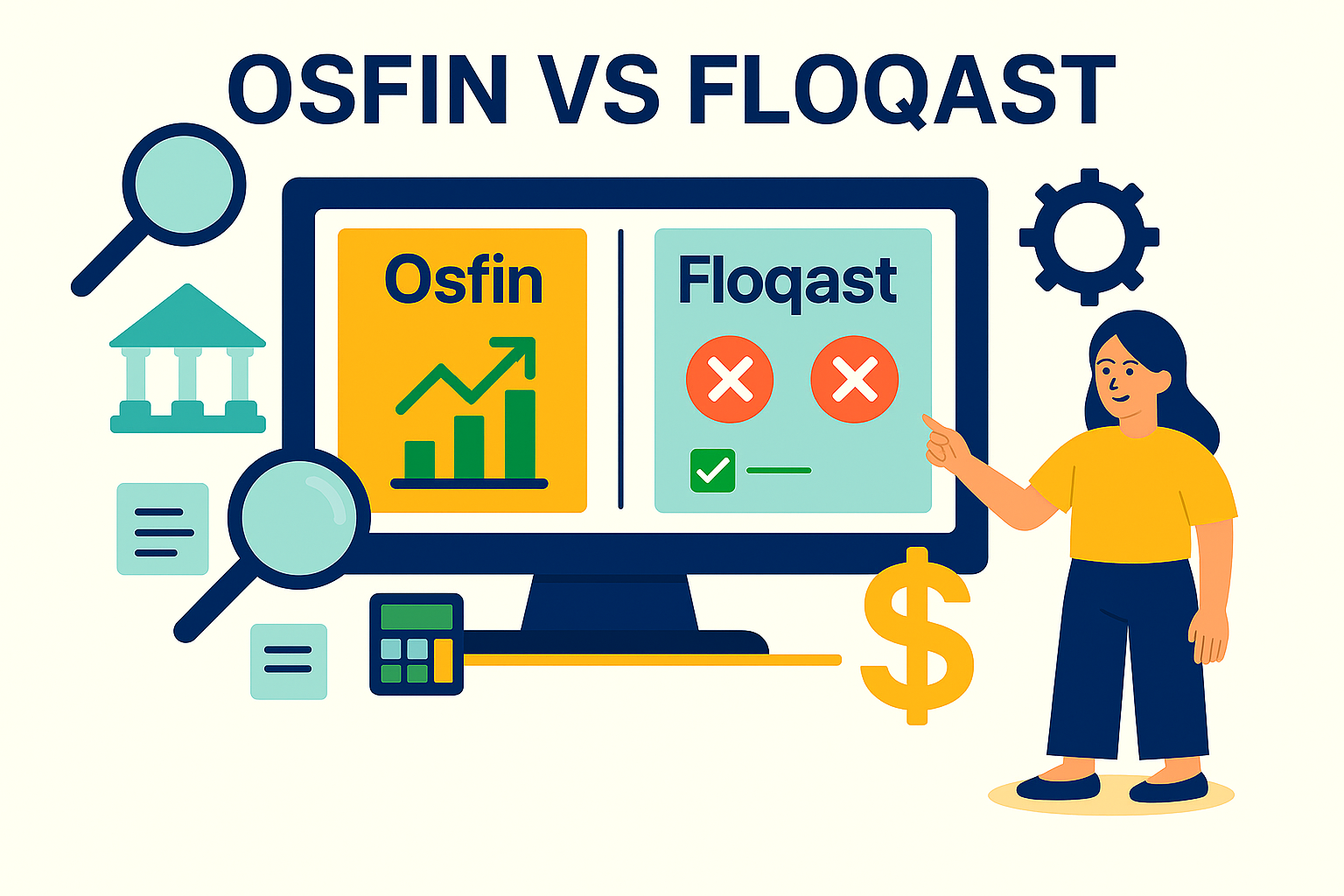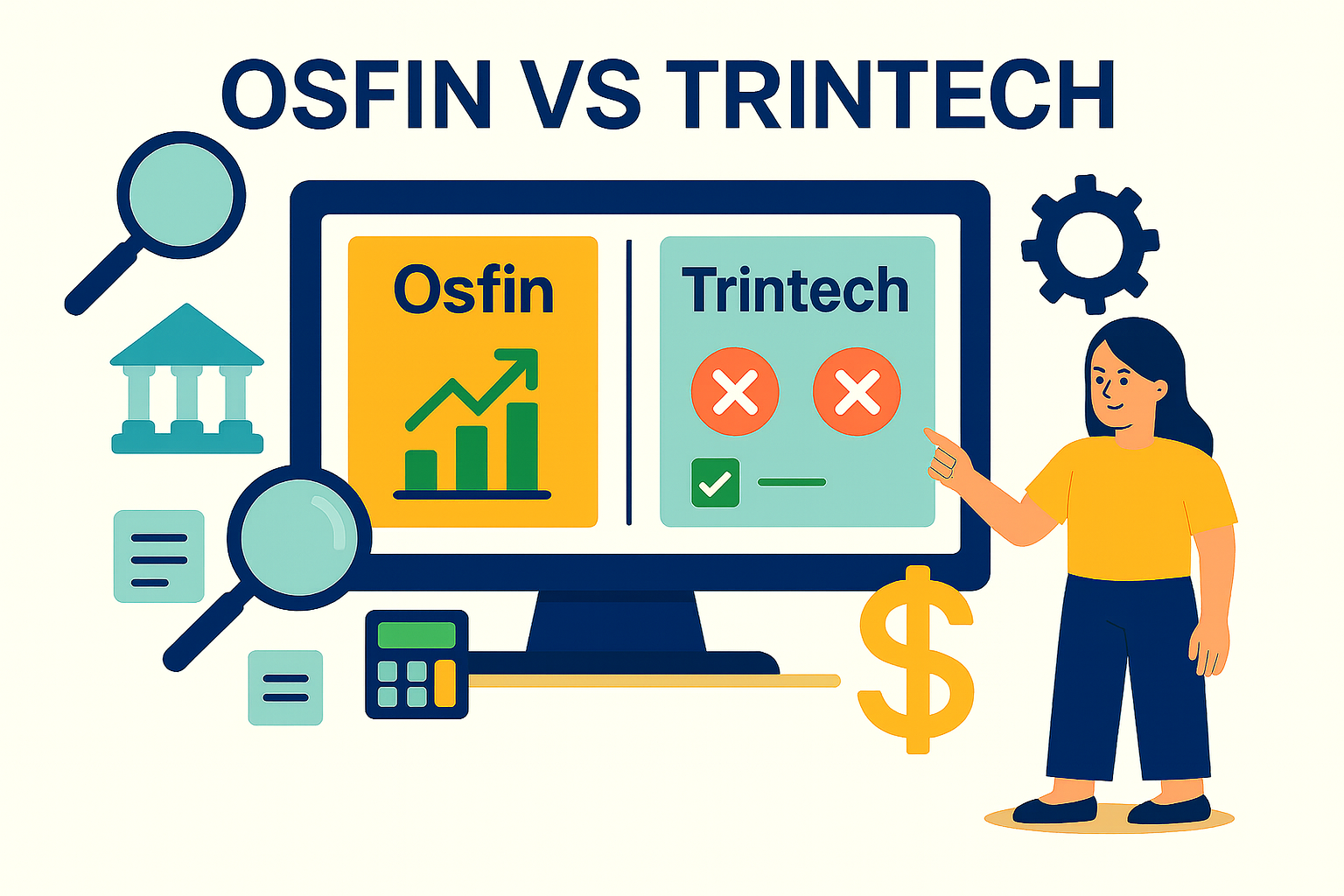What Are Bank Lockboxes & How Automation Enhances Them
Bank lockboxes have been around since the 1940s, first introduced to help large corporations simplify the task of check collection and speed up deposits. Over time, they became a core instrument for handling large amounts of incoming payments that could be conducted more efficiently.
Even in today's digital-first world, many B2B payments are still made via check. Companies still depend on them because they are familiar with legacy workflows. However, check handling is time-consuming, error-prone, and drains valuable resources. That’s where lockbox services come in; they replace manual processing challenges, reduce delays, and accelerate the cash conversion process. At the same time, they enhance record accuracy and significantly reduce operational workload.
Bank lockboxes provide companies with a modern way to improve cash flow and automate collections. This article will explore what is a lockbox in banking, how it works, and how automation tools like Osfin transform lockbox operations.
What this blog covers:
- What a bank lockbox service is and how it works
- Benefits of using lockboxes for businesses: faster collections, less manual handling
- Common variations of lockbox models and how to choose the right one
- Challenges and best practices in managing lockbox payments
- How automation tools like Osfin can enhance lockbox reconciliation and cash-flow visibility
What is a Lockbox?
A bank lockbox payment is a service that enables businesses to receive customer payments at a reserved and managed post office box, which the respective bank owns. Instead of sending checks to the company, customers mail them to this lockbox, where the money is collected and processed by the bank, and then deposited directly to the business’ bank account.
This set-up speeds up the collection process, minimizes the delay of mail and deposits, and minimizes paperwork for the business. Lockbox banking is highly beneficial for companies handling many check payments, which would help streamline accounts receivable, provide a better understanding of cash flow, and improve the overall efficiency of lockbox payment processing mechanisms.
Importance of Bank Lockboxes in Financial Management
Here are some reasons why using lockbox for payments can be strategically vital for modern finance teams:
1. Enhances Financial Governance
Consistency and accountability throughout payment processes, which are fundamental to proper financial governance, are ensured by processing payments within a centralized environment, reducing discrepancies, enforcing uniform procedures, and enabling clear audit trails.
2. Supports Risk Mitigation
Lockboxes also help reduce the risks of fraud and errors in receivables by minimizing internal handling of checks. There is also very little room for checks being misplaced, tampered with, or handled by internal staff due to direct delivery of checks to the bank.
3. Improves Financial Forecasting
Faster deposits and reporting allow more accurate cash flow predictions and liquidity planning.
4. Aligns with Audit & Compliance Objectives
Bank-managed secure systems offer audit trails and paperwork that can be traced to meet auditors' and regulatory requirements.
5. Strengthens Strategic Finance Functions
Automating the low-value tasks enables the finance team to spend time on strategic analysis, making investment decisions, and allocating capital.
How Does Lockbox Work?
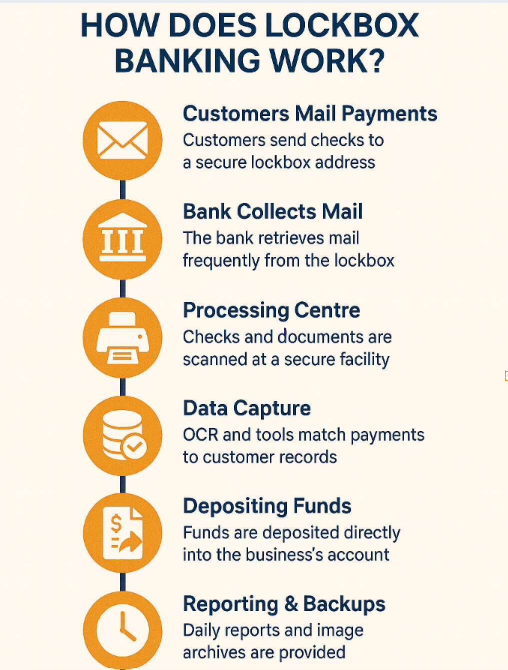
Lockbox banking has a systematic approach to the collection and faster payment. Here’s how it works:
1. Customers Mail Payments
Businesses offer a special (lockbox) post office to which customers can send checks.
2. Bank Collects Mail
The bank gathers the mail from all lockboxes several times a day.
3. Processing Centre
The bank opens the mail envelope at a secure facility and scans the checks and remittance documents.
4. Data Capture
The bank captures payment data and matches it with the business’s accounts receivable records using OCR and imaging tools.
5. Depositing Funds
Once verified, the bank deposits the checks into the business’s account.
6. Reporting & Backups
Daily check and payment information, with an image, are reported in enterprises. The data is also backed up daily.
7. Faster Access
Nationwide lockbox networks ensure faster delivery of payments and processing of checks, thus accelerating cash flow and reducing delivery time.
Benefits of Using a Bank Lockbox
Bank lockbox services offer several benefits to help streamline incoming payments. Here are some benefits:
1. Faster Payment Processing
Lock boxes lessen the size of mail float and accelerate the check clearance, increasing access to funds. These payments are even processed after the bank's timing, which helps businesses access funds quickly.
2. Improved Cash Flow
Lockboxes speed up deposits and enhance cash flow while reducing delays, fraud, and risks linked to internal check handling.
3. Enhanced Security
Banks apply strict security protocols to protect check payments and lockbox cash management, reducing fraud, theft, or loss compared to office-based handling.
4. Reduced Processing Costs
Automation eliminates manual data entry, avoiding labour and overhead costs with reduced errors.
5. Increased Operational Efficiency
Lockboxes handle incoming checks by converting them into digital data, reducing manual effort and freeing staff to focus on core business activities.
6. Better Customer Service
There are fewer errors and more customer satisfaction since issues can be resolved faster, and billing is more accurate.
7. 24/7 Flexibility
Lockbox services are not limited by business hours, so companies have more flexibility when receiving their payments than with in-house deposits.
8. Simplified Reconciliation
The payment details that the banks supply are in a detailed and consolidated form and can be easily loaded on the accounting systems; therefore, the reconciliation process becomes easy.
{{banner1}}
Use Cases for Lockbox Systems
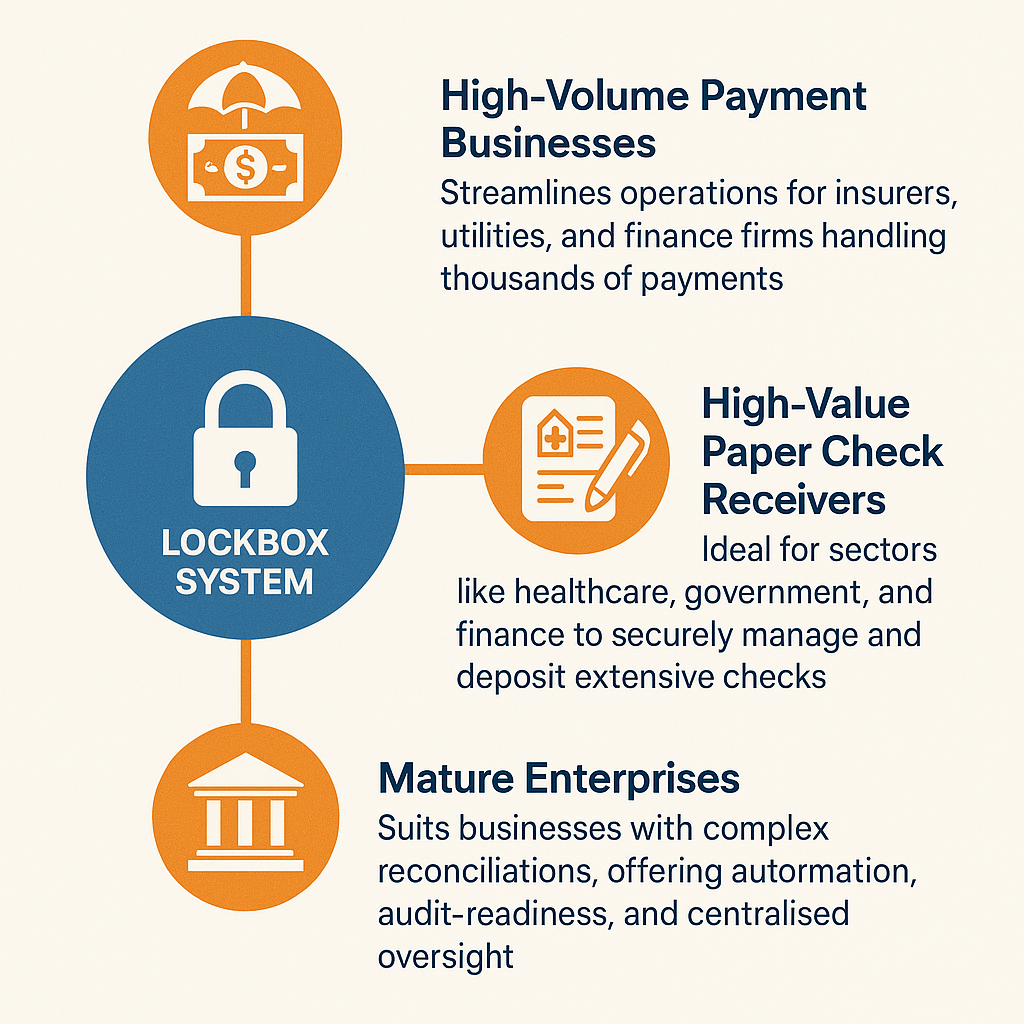
The bank lockbox schemes can apply to industries that use many paper checks. The following are useful practical applications:
1. High-Volume Payment Businesses
Insurance companies, utilities, and financial organisations process large volumes of payments from customers. Lockbox systems can integrate collections into one central place, minimise manual processes, and improve reconciliation work. This makes it a perfect fit for companies interested in accelerating cash flow without scaling their internal teams.
2. Organisations Receiving High-Value Paper Checks
Paper checks remain common in high-value transactions despite digital alternatives. Lockboxes are helpful in all companies, including finance, healthcare, and government. It helps them to deposit checks securely, simplify the liquidity process, and avoid delays caused by in-house processing.
3. Large Enterprises with Complex Payment Operations
Payment reconciliation can be complex and time-consuming in established organisations with multiple revenue streams. By automating routine processes, Lockbox services help centralise incoming payments, streamline audit documentation, and reduce manual tasks. This makes them a strategic choice for improving financial control, operational efficiency, and scalability.
What is Lockbox Processing & Reconciliation?
Banks receive customer payments, typically paper checks, on behalf of businesses through lockbox services. They open, scan, make deposits, and send payment information in digital form. This accelerates the cash cycle, shortens the mail float, removes in-house check processing operations, and allows businesses to receive payments faster and focus resources on core financial operations.
Lockbox reconciliation means comparing the payment information received through checks, lockbox remittance documents, and client instructions across the bank’s internal systems. Automatic reconciliation systems can also make this process faster and more accurate, helping banks match and validate incoming funds across multiple sources. It significantly improves efficiency and visibility and reduces reconciliation errors across the lockbox processing workflow.
{{banner3.1}}
How to Implement a Bank Lockbox System?
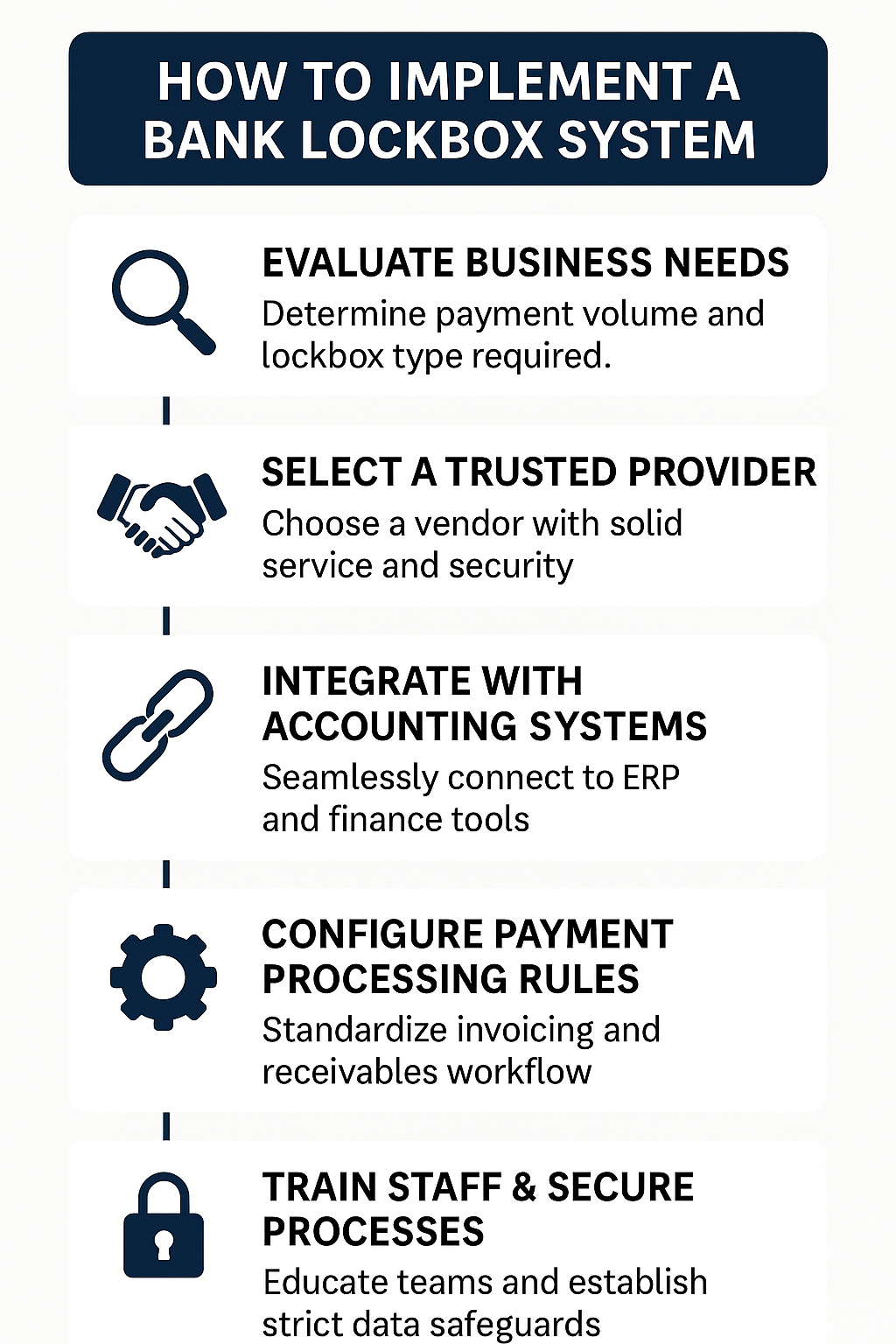
Implementing a bank lockbox system involves a few strategic steps to ensure smooth setup, integration, and operation. These are the key steps:
1. Evaluate Business Needs
Evaluate the payment volume and customer type to determine whether to get a retail or wholesale lockbox solution that would suit business requirements.
2. Select a Trusted Provider
Select a trusted provider with streamlined functions, excellent security, and good customer service within a given budget and according to industry needs.
3. Integrate with Accounting Systems
Work with your vendor and internal teams to integrate the lockbox service seamlessly with your existing ERP systems or accounting software.
4. Configure Payment Processing Rules
Regulate payment options, the forms of invoicing, and processing guidelines of receivables to streamline the flow of receivables.
5. Train Staff and Secure Processes
Train finance personnel about the lockbox models and automation systems, and establish high security measures concerning financial data.
Lockbox Processing Challenges
Here are some lockbox processing challenges:
1. High Operational Costs
Lockbox services are costly, mainly when some of these charges are accrued at very high rates, especially for businesses with few checks.
2. Limited Payment Flexibility
Lockboxes are primarily designed for check payments. Businesses that allow payment using a mobile app, an online system, or any other digital wallet might require a separate system to account for these sources.
3. Security and Fraud Risks
Lockbox access is often unsupervised, making it vulnerable to check fraud or counterfeiting. Without strong security controls, sensitive information on checks may fall into the wrong hands.
4. Reliance on Bank Efficiency
The lockbox process is only as reliable as the bank handling it. Delays, errors, or poor bank management can hinder cash application and reconciliation timelines.
5. Reconciliation Across Systems
From the bank’s side, reconciling lockbox transactions is not easy. Payment data comes in various formats, such as PDFs, scanned remittances, client instructions, and must be matched against internal ledgers, core banking systems, and clearing files. Without intelligent automation, this becomes a time-consuming, error-prone process that bottlenecks financial reporting and compliance.
{{banner1.1}}
How Osfin Automates Lockbox Reconciliation?
Lockbox transaction reconciling is usually time-consuming manual work with inconsistent data on remittance, bank statements, and ERP entry, which can cause inaccurate reconciliation. This slows down cash application and introduces compliance risks. That’s where Osfin comes in.
Osfin.ai automates lockbox reconciliation using rules based logic to match transactions across multiple sources, detect real-time exceptions, and synchronize data across systems. Its agnostic format reads and normalizes unstructured remittance data such as checks, images, PDFs, and bank files, then matches them to correct ledger entries despite incomplete or non-corresponding data. By supporting all the leading formats and including over 170 pre-built integrations, Osfin makes speed, accuracy, and audit-readiness scalable.
Osfin.ai key features for lockbox reconciliation include:
1. Unstructured Data Parsing
Extracts and standardises data from PDFs, scanned checks, remittance images, and more.
2. Smart Reconciliation Engine
Matches payments to remittance data using AI-driven logic, even with missing or partial references.
3. Duplicate & Anomaly Detection
Identifies duplicates and outliers during ingestion, reducing manual review and downstream errors.
4. Real-Time Exception Management
Instantly flags mismatches, duplicates, or outliers and routes them to the right teams.
5. Audit & Compliance Ready
SOC 2, PCI DSS, ISO 27001, and GDPR aligned, with full transaction traceability and encrypted access.
6. 170+ Integrations & Fast Deployment
Works with ERPs, CBS, bank APIs, and processors—set up quickly with expert support.
7. Expert Guidance
Ongoing assistance from professionals who understand the complexity of reconciliation and finance operations.
8. No-Code Rule Builder
Lets you customize tolerance levels, matching logic, and workflows without writing a single line of code.
{{banner3}}
FAQs on Bank Lockboxes
1. What is a lockbox payment?
Lockbox payments, meaning payments made through lockbox processing involves a bank collecting, scanning, and depositing customer payments sent to a designated post office box.
2. What is a bank lockbox used for?
A bank lockbox is used by businesses for the collection and processing of customer payments made through checks. Instead of mailing payments to the business directly, customers send them to a secure lockbox managed by the bank.
3. What is lockbox banking’s benefit?
Businesses with high payment volumes or paper checks, such as insurers, utilities, and hospitals get the benefits of speed, accuracy, and control.
4. Can lockbox systems integrate with ERP software?
Absolutely. The advanced lockbox systems can reconcile and report through integration within the existing business platforms, such as ERP, and other accounting systems in automation.
5. What is the bank’s lockbox payment process?
Banks often collect and process payments multiple times daily, enabling faster deposits and improving cash flow cycles.
